Instruments
|
Note: Hitomi (formerly ASTRO-H) was a high-energy astrophysics space observatory, developed by the Japan Aerospace Exploration Agency (JAXA) in collaboration with institutions in Japan, the US, Canada, and Europe. It carried four instruments that together spanned the energy range 0.3-600 keV. The science goals of this mission included studying the dynamics of hot gas in galaxy clusters, the accretion of matter onto supermassive black holes at the cores of distant galaxies, and the acceleration of cosmic-ray particles up to very high energies. The mission was launched on 17 February 2016 at 08:45 UTC. On 28 April 2016, JAXA announced that they would discontinue operations of Hitomi as it was no longer possible to communicate with the satellite following an anomaly which appeared to have resulted in both solar array paddles having broken off from the spacecraft body. In June 2017, ESA announced that it will participate in Japan's X-ray Astronomy Recovery Mission (XARM), designed to recover the science of the Hitomi mission. |
The Hitomi satellite (known as ASTRO-H prior to launch) is equipped with a suite of four state-of-the-art instruments: a high-resolution spectrometer and a wide-field imager, both sensitive to soft X-ray photons; a hard X-ray imaging system; and a non-focusing detector of soft gamma rays. The four instruments are co-aligned so they are able to observe the same portion of the sky at the same time.
With the highest energy resolution ever achieved in the 3-10 keV band and a broad energy range, spanning four decades from soft X-rays to gamma rays, Hitomi promises to provide many breakthrough discoveries, improving our understanding of some of the most powerful phenomena in the Universe.
Soft X-ray Spectrometer
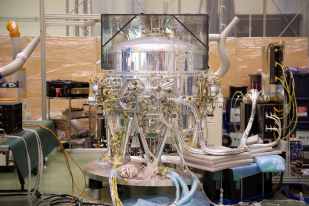 |
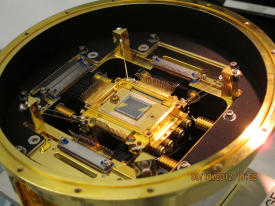 |
| Soft X-ray Spectrometer. Credit: JAXA | X-ray Calorimeter Spectrometer. Credit: NASA |
The Soft X-ray Spectrometer (SXS) is a high-resolution, high-throughput spectrometer sensitive to photons with energy between 0.3 keV and 12 keV. This non-dispersive spectrometer, based on a calorimeter rather than on a grating, can achieve a spectral resolution of less than 7 eV – much higher than what is accessible to current grating spectrometers at energies higher than 2 keV.
The spectrometer system consists of one of the two Soft X-ray Telescopes (SXT-2) to focus the photons, the X-ray Calorimeter Spectrometer (XCS), and a cooling system. It also contains a filter wheel to prevent strong X-ray sources from saturating the spectrometer and to illuminate the field of view of the instrument with a standard calibration source for monitoring and continuously adjusting the energy scale of the instrument. The filter wheel complements one calibration pixel on the XCS array, which operates continuously to correct the instrument energy scale for possible fluctuations of the operational temperature on time scales of few minutes.
The XCS array consists of micro-machined, ion-implanted Si thermistors, with HgTe absorbers attached to them to provide higher quantum efficiency. The array contains 36 pixels, with a size of 814 μm each. Taking into account the 5.6-m focal length of the Soft X-ray Telescope, the resulting field of view is of 3' × 3'.
To obtain high energy resolution, the array must be cooled down to about 50 mK. Such low temperatures are common for infrared and sub-millimetre space telescopes, which cool the detectors using cryogenic fluids; the XCS on Hitomi will use a series of mechanical coolers instead. Apart from rocket flights of short duration, no X-ray instruments operating at such low temperatures have been successfully flown to date.
Soft X-ray Imager
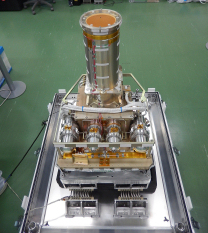 |
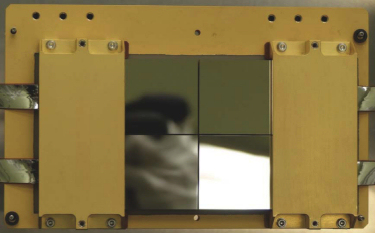 |
| Soft X-ray Imager. Credit: JAXA | X-ray CCD camera. Credit: JAXA |
The Soft X-ray Imager (SXI) is a wide-field imaging system, receiving light from one of the two Soft X-ray Telescopes (SXT-1). The detector, an X-ray-sensitive silicon CCD camera, records photons with energy between 0.4 keV and 12 keV and can operate at temperatures around 153 K.
The camera consists of a 2×2 array of back illuminated CCDs, each having an imaging area of 3 cm on a side, spanning 1280 pixels with a size of 24 μm each. Taking into account the 5.6-m focal length of the Soft X-ray Telescope, the resulting field of view is of 38' × 38', larger than those of ESA's XMM-Newton and NASA's Chandra X-ray observatories.
Hard X-ray Imager
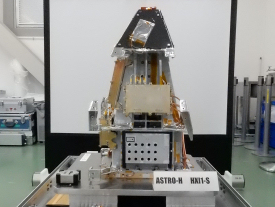 |
| Hard X-ray Imager. Credit: JAXA |
The Hard X-ray Imager (HXI) is an imaging system that receives photons with energy between 5 keV and 80 keV, focussed by either of the two Hard X-ray Telescopes, which have a focal length of 12 m. The sensors are located in two units, each receiving light from one of the two telescopes. They consist of four layers of 0.5-mm-thick Double-sided Silicon (Si) Strip Detectors (DSSDs), to absorb photons with energy below 20 keV and reduce the detector background noise, and one layer of 0.75-mm-thick Cadmium Telluride (CdTe), a double-sided cross-strip detector sensitive to photons with energy between 20 and 80 keV.
Soft Gamma-ray Detector
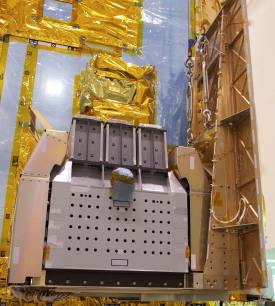 |
| Soft Gamma-ray Detector. Credit: JAXA |
The Soft Gamma-ray Detector (SGD) is a non-focusing instrument sensitive to photons with energy between 40 keV and 600 keV. It consists of two identical units, each containing a Compton camera that consists of a stack of Si and CdTe pixellated detectors. The narrow field-of-view collimator outperforms the background rejection capability of previous soft gamma ray detectors.
Events are recorded when photons interact twice with the detector, first by Compton scattering in the stack of Si strip detectors, and then by photo-absorption in the CdTe part (Compton mode). By measuring the location and energy of the two interactions, it is possible to estimate the energy and incoming direction of the incident gamma ray.
While primarily a spectrometer in the 40–600 keV energy band, the SGD is also sensitive to polarisation in the 50–200 keV energy band.
| Soft X-ray Spectrometer (SXS) | |
| Detector: | micro calorimeter |
| Focal length: | 5.6 m |
| Effective area: | 210 cm² (at 6 keV); 160 cm² (at 1 keV) |
| Energy range: | 0.3–12 keV |
| Energy resolution (FWHM): | <7 eV (at 6 keV) |
| Angular resolution: | <1.7 arcmin |
| Effective Field of View: | 3 × 3 arcmin² |
| Time resolution: | 80 μs |
| Operating temperature: | 50 mK |
| Soft X-ray Imager (SXI) | |
| Detector: | X-ray CCD |
| Focal length: | 5.6 m |
| Effective area: | 360 cm² at 6 keV |
| Energy range: | 0.4–12 keV |
| Energy resolution (FWHM): | 200 eV (at 6 keV) |
| Angular resolution: | <1.7 arcmin |
| Effective Field of View: | 38 × 38 arcmin² |
| Time resolution: | 4 s/0.1 s |
| Operating temperature: | 153 K |
| Hard X-ray Imager (HXI) | |
| Detector: | Si/CdTe cross-strips |
| Focal length: | 12 m |
| Effective area: | 300 cm² at 30 keV |
| Energy range: | 5–80 keV |
| Energy resolution (FWHM): | 2 keV (at 60 keV) |
| Angular resolution: | <1.7 arcmin |
| Effective Field of View: | 9 × 9 arcmin² |
| Time resolution: | 60 μs |
| Operating temperature: | 253 K |
| Soft Gamma-ray Detector (SGD) | |
| Detector: | Si/CdTe Compton Camera |
| Focal length: | – |
| Effective area: | >20 cm² at 100 keV (Compton mode) |
| Energy range: | 40–600 keV |
| Energy resolution (FWHM): | <4 keV (at 60 keV) |
| Angular resolution: | – |
| Effective Field of View: | 0.6 × 0.6 deg² (at < 150 keV) |
| Time resolution: | 1 ms |
| Operating temperature: | 253 K |
